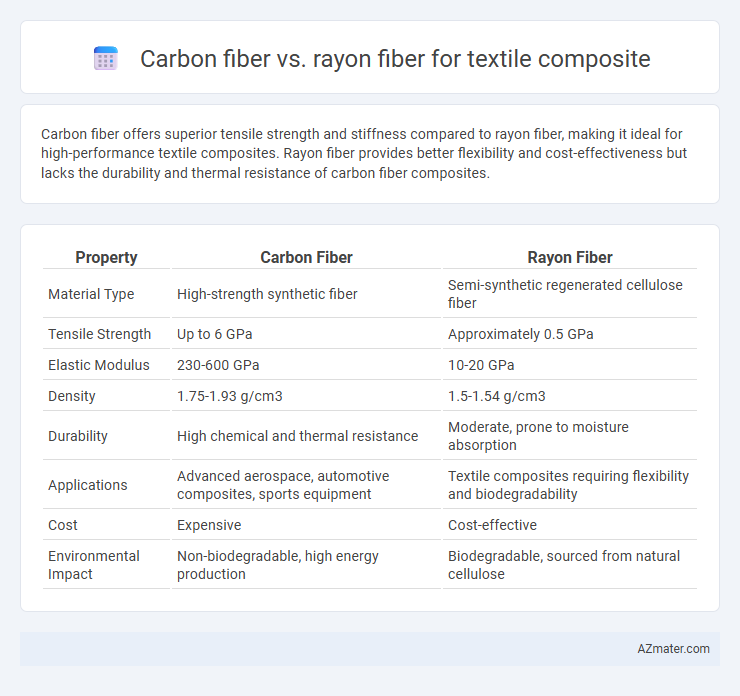Carbon fiber offers superior tensile strength and stiffness compared to rayon fiber, making it ideal for high-performance textile composites. Rayon fiber provides better flexibility and cost-effectiveness but lacks the durability and thermal resistance of carbon fiber composites.
Table of Comparison
| Property | Carbon Fiber | Rayon Fiber |
|---|---|---|
| Material Type | High-strength synthetic fiber | Semi-synthetic regenerated cellulose fiber |
| Tensile Strength | Up to 6 GPa | Approximately 0.5 GPa |
| Elastic Modulus | 230-600 GPa | 10-20 GPa |
| Density | 1.75-1.93 g/cm3 | 1.5-1.54 g/cm3 |
| Durability | High chemical and thermal resistance | Moderate, prone to moisture absorption |
| Applications | Advanced aerospace, automotive composites, sports equipment | Textile composites requiring flexibility and biodegradability |
| Cost | Expensive | Cost-effective |
| Environmental Impact | Non-biodegradable, high energy production | Biodegradable, sourced from natural cellulose |
Introduction to Carbon Fiber and Rayon Fiber
Carbon fiber, known for its exceptional strength-to-weight ratio and high tensile strength, is widely used in advanced textile composites for aerospace, automotive, and sporting goods applications. Rayon fiber, derived from regenerated cellulose, offers biodegradability and excellent moisture absorbency, making it a popular choice in textile composites focused on sustainability and comfort. The contrasting properties of carbon fiber's rigidity and rayon fiber's flexibility enable diverse performance characteristics in composite materials.
Overview of Textile Composites
Textile composites combine fibers such as carbon fiber and rayon fiber to enhance mechanical properties, with carbon fiber providing exceptional tensile strength, stiffness, and lightweight characteristics ideal for high-performance applications. Rayon fiber, derived from regenerated cellulose, offers biodegradability and cost-effectiveness while improving toughness and flexibility within composite matrices. The integration of carbon fiber and rayon fiber in textile composites enables tailored performance, balancing durability, sustainability, and manufacturing adaptability for aerospace, automotive, and sporting goods sectors.
Material Structure: Carbon Fiber vs Rayon Fiber
Carbon fiber features a tightly packed, graphitized structure with high crystallinity and aligned carbon atoms, leading to superior tensile strength and stiffness in textile composites. Rayon fiber, derived from regenerated cellulose, possesses a semi-crystalline structure with lower molecular alignment, resulting in moderate mechanical properties but enhanced flexibility and dye affinity. The distinct differences in molecular arrangement between carbon and rayon fibers directly influence the performance and application scope of textile composites.
Mechanical Properties Comparison
Carbon fiber offers superior tensile strength and stiffness compared to rayon fiber, making it ideal for high-performance textile composites requiring exceptional load-bearing capacity. Rayon fiber exhibits lower mechanical properties but provides better flexibility and impact resistance, which suits applications needing lightweight and less brittle materials. The modulus of elasticity for carbon fiber typically exceeds 230 GPa, while rayon fiber ranges around 20-30 GPa, highlighting the significant difference in structural reinforcement capabilities.
Weight and Density Differences
Carbon fiber exhibits a significantly lower density, approximately 1.6 g/cm3, compared to rayon fiber, which ranges around 1.5 to 1.54 g/cm3 but typically contributes more to composite weight due to its cellulose-based structure. The high strength-to-weight ratio of carbon fiber allows for lighter composite materials, making it ideal for applications demanding minimal weight with maximum structural integrity. Rayon fiber's density and hydrophilic nature often result in higher composite weight and reduced performance in weight-sensitive applications.
Durability and Lifespan in Composites
Carbon fiber exhibits superior durability and longer lifespan in textile composites due to its high tensile strength, excellent corrosion resistance, and minimal fatigue degradation compared to rayon fiber. Rayon fiber composites tend to degrade faster under environmental stressors like moisture and UV exposure, resulting in reduced mechanical performance and shorter service life. Consequently, carbon fiber is preferred for applications demanding extended durability and sustained structural integrity.
Manufacturing Processes and Compatibility
Carbon fiber manufacturing involves high-temperature pyrolysis of polyacrylonitrile (PAN), resulting in strong, lightweight filaments ideal for high-performance textile composites. Rayon fiber production uses a chemical regeneration process from cellulose, offering cost-effective compatibility with cellulose-based resins but lower thermal stability. Carbon fiber composites demand precise curing cycles due to their sensitivity to heat and resin types, while rayon fiber composites benefit from more straightforward processing with conventional textile manufacturing equipment.
Cost Analysis and Economic Feasibility
Carbon fiber composites exhibit superior strength-to-weight ratios but incur significantly higher production costs compared to rayon fiber composites, which offer more economical raw material prices and processing techniques. The economic feasibility of using carbon fiber depends on application-specific performance demands justifying the premium price, while rayon fiber serves as a cost-effective alternative in less critical structural applications. Cost analysis reveals that rayon fiber composites reduce initial expenditure and enable faster manufacturing cycles, beneficial for large-scale textile production aiming to balance performance and budget constraints.
Environmental Impact and Sustainability
Carbon fiber exhibits higher strength-to-weight ratios but involves energy-intensive manufacturing processes and non-renewable raw materials, leading to significant carbon emissions. Rayon fiber, derived from cellulose, offers biodegradability and lower environmental impact, though its production depends heavily on chemical treatments that can harm ecosystems if not managed properly. Sustainable textile composites increasingly favor rayon for eco-friendly applications, while carbon fiber remains preferred for high-performance uses despite its environmental drawbacks.
Applications and Industry Use Cases
Carbon fiber offers superior strength-to-weight ratio and high stiffness, making it ideal for aerospace, automotive, and high-performance sports equipment. Rayon fiber, valued for its flexibility and cost-effectiveness, finds extensive use in fashion textiles, upholstery, and lightweight composite materials for consumer goods. Textile composites combining carbon fiber with rayon enhance durability and design versatility across industrial applications such as protective clothing and automotive interiors.

Infographic: Carbon fiber vs Rayon fiber for Textile composite
 azmater.com
azmater.com